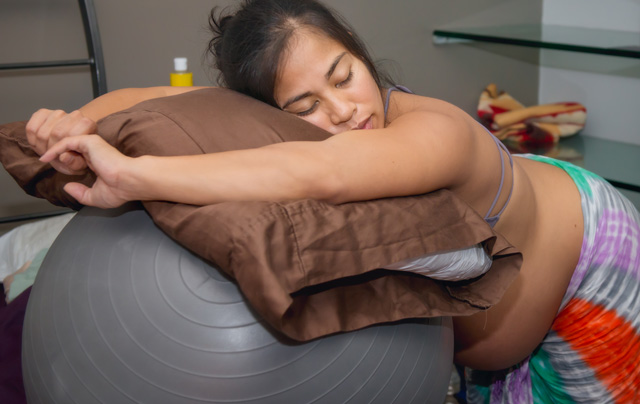Why do women give birth lying on their backs?
It's all down to King Louis XIV...


Why do women give birth lying on their backs? Well, you might be surprised to learn that it seems to have much more to do with history rather than biology.
If you're pregnant, you'll have lots of questions about childbirth, especially as you get closer to your due date and start to formulate a birthing plan. One of these - why do women give birth lying on their backs? - crops up a lot and you're not alone in questioning if it has always been this way, and if there are other positions that might make labour easier. Knowing the history about why so many women give birth lying down might help you make a better informed decision about how you want to give birth and we asked experts for their input too:
Why do women give birth lying on their backs?
The idea of women giving birth lying on their backs on a bed wasn't actually introduced until around the 1700's, according to hypnobirthing expert Katharine Graves.
Writing in her well-known publication The Hypnobirthing Book, Katharine explains that women only began to give birth flat on their backs because King Louis XIV wanted to see his mistress give birth - not because it aided labour.
At the time, women generally laboured squatting on stools, and the midwife would usually be at floor level to meet the baby.
'But kings don't grovel on the floor, so it all had to be frightfully proper and his mistress had to lay in a bed,' Katharine writes.

Women in the King's court copied this, and midwives found they had much more difficulty getting babies out when mothers lay flat, so doctors were called in a lot more often.
Parenting advice, hot topics, best buys and family finance tips delivered straight to your inbox.
Soon word spread and everyone started giving birth whilst lying down, believing that if it was done in the royal household then it must be for the best.
This trend for lying down has stuck, particularly in the Western hemisphere. Interestingly, the media often perpetuates it.
'I think the reason we see less squatting these days is because so many women now choose to birth in hospital,' says birth educator and yoga instructor Lucy Flow. 'We see in movies and on TV that women go to hospital to give birth and lay on their backs. So, a pregnant woman giving birth in hospital is likely to do what she's seen since she was little,' she explains.

'Women have only started to birth on their backs in relatively modern history,' adds women's health expert and founder of Forage Botanicals Natasha Richardson. 'When birth was an event which occurred in the home, surrounded by other women, a pregnant person was likely to move into whatever position suited them,' she says. 'Often, they'd crouch or be on all fours. This promotes a posture where gravity can do a lot of the work.'
'We continue to give birth on our backs because of the physical design of hospitals and beliefs about birth,' adds Natasha.
Is it better to give birth squatting or lying down?
Katharine, who is a leading hypnobirthing teacher and associate member of the Royal college of Midwives, claims that squatting is one of the best and most natural positions for childbirth, because "you have gravity on your side and you have the maximum pelvic capacity [in this position]."
Squatting can help to deliver a baby more swiftly. During childbirth the baby moves down towards the coccycx, which has a natural curve up. When squatting, this flexes and moves as your baby makes its way down the birth canal.

'Lying on your back whilst giving birth decreases contractions,' says Natasha. 'It makes a back-to-back birth more likely, makes gravity work against you as the baby is pushed towards your back and needs to come out over your coccyx (you're essentially pushing uphill), and it decreases the baby's pressure on the cervix and therefore decreases cervical dilation,' she argues. 'Squatting is better as it does the opposite of everything I've mentioned.'
But if lying down can make giving birth harder, why is it an option? One reason is that it can help medical staff. 'Giving birth on your back is convenient for caregivers,' explains Lucy. 'Especially if there's a medical reason for requiring a better view, such as the woman consenting to an episiotomy, a vaginal examination, or forceps.'
'Personally, I recommend women give birth in any position that opens the pelvis and uses gravity,' she continues. 'Most importantly, it should be a position the woman feels comfortable in. Sometimes that position is squatting. We are mammals. Mammals are designed to give birth upright. Evidence shows that being upright and using gravity has much better outcomes for the woman. This is not only physical. Lots of women report feeling more confident, in control, and positive about their birth experience when using upright positions.'
'If a woman wants to be on her back because she feels good there, then of course she should. Often it's more a case of her not realising the benefits of being upright,' adds Lucy.

Many women find that having a water birth allows them to move about upright more freely, but what about other positions? 'Lying on the side can let you rest without creating the same amount of pressure on the coccyx as being on your back,' says Natasha. 'While being on all fours helps the baby swing around so its back is away from your back. If the mother then rests her upper body on a surface (such as a birthing ball, £22.95, Amazon) – so her chest is above her hips – this helps the baby slide towards the cervix, increasing oxytocin and contractions,' she advises.
'Standing is also a good posture but you might find this difficult in later stages of labour,' she adds. 'Therefore, holding onto your partner's neck like you're on a dance floor may help. Essentially keeping your chest above and forwards from your hips is usually the most beneficial position.'
Video of the Week:

Debra Waters is an experienced online editor and parenting writer. She also has a strong background on health, wellbeing, beauty, and food. She currently writes for Goodto and Woman&Home, and print publications Woman, Woman’s Own, and Woman’s Weekly. Debra has written for What to Expect, Everyday Health, and Time Out. In addition, she has had articles published in The Telegraph and The Big Issue.